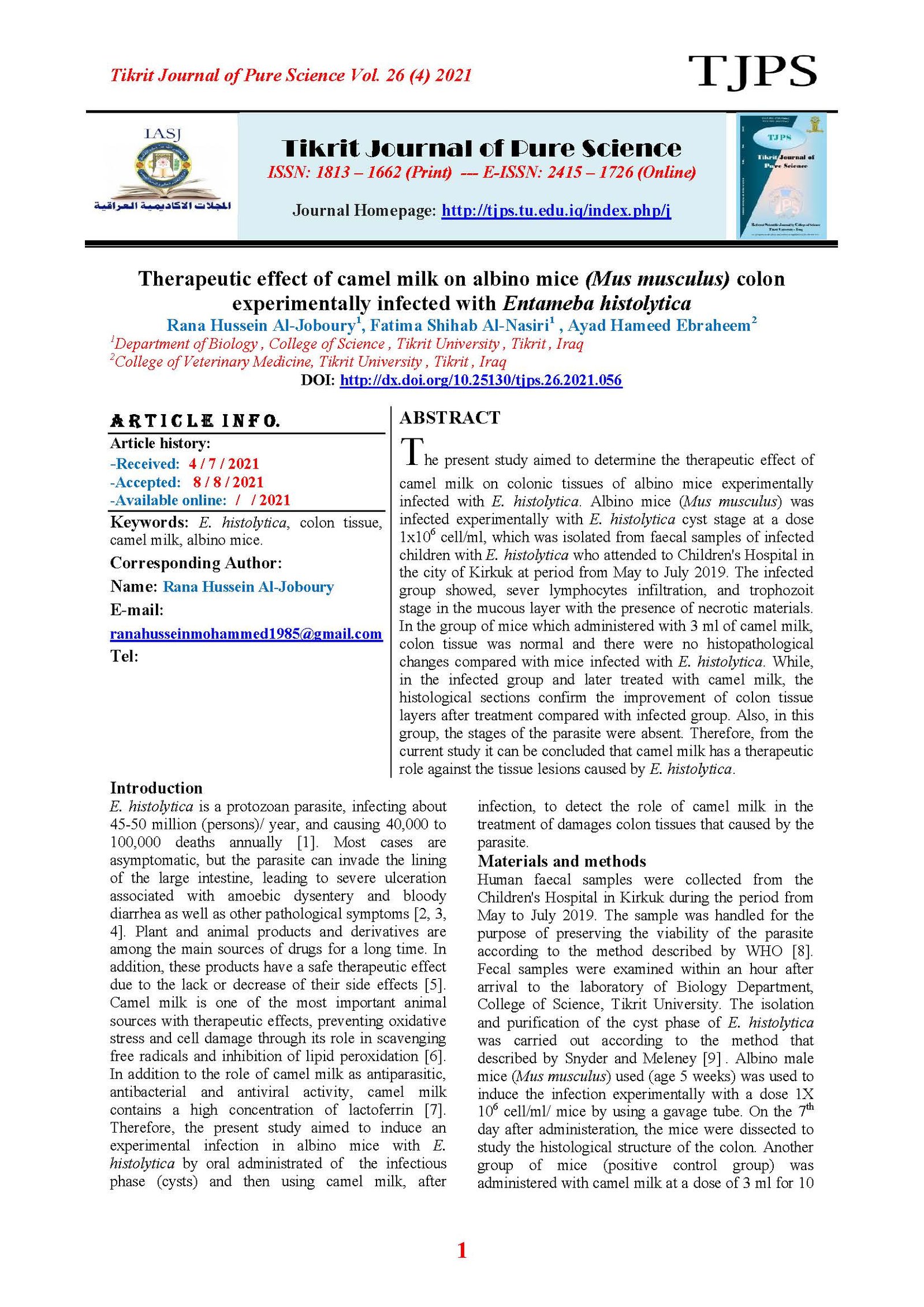Therapeutic effect of camel milk on albino mice (Mus musculus) colon experimentally infected with Entameba histolytica
Main Article Content
Abstract
The present study aimed to determine the therapeutic effect of camel milk on colonic tissues of albino mice experimentally infected with E. histolytica. Albino mice (Mus musculus) was infected experimentally with E. histolytica cyst stage at a dose 1x106 cell/ml, which was isolated from faecal samples of infected children with E. histolytica who attended to Children's Hospital in the city of Kirkuk at period from May to July 2019. The infected group showed, sever lymphocytes infiltration, and trophozoit stage in the mucous layer with the presence of necrotic materials. In the group of mice which administered with 3 ml of camel milk, colon tissue was normal and there were no histopathological changes compared with mice infected with E. histolytica. While, in the infected group and later treated with camel milk, the histological sections confirm the improvement of colon tissue layers after treatment compared with infected group. Also, in this group, the stages of the parasite were absent. Therefore, from the current study it can be concluded that camel milk has a therapeutic role against the tissue lesions caused by E. histolytica.
Article Details

This work is licensed under a Creative Commons Attribution 4.0 International License.
Tikrit Journal of Pure Science is licensed under the Creative Commons Attribution 4.0 International License, which allows users to copy, create extracts, abstracts, and new works from the article, alter and revise the article, and make commercial use of the article (including reuse and/or resale of the article by commercial entities), provided the user gives appropriate credit (with a link to the formal publication through the relevant DOI), provides a link to the license, indicates if changes were made, and the licensor is not represented as endorsing the use made of the work. The authors hold the copyright for their published work on the Tikrit J. Pure Sci. website, while Tikrit J. Pure Sci. is responsible for appreciate citation of their work, which is released under CC-BY-4.0, enabling the unrestricted use, distribution, and reproduction of an article in any medium, provided that the original work is properly cited.
References
]1[ Al-Oumashi, G. B.; Khairi, A. and Dawood, A. H. (2012). Evaluation of immunoglobulin m (IgM) and interleukin 2 (il-2) assay in true infection of Entamoeba histolytica. Iraqi J. Biotechnol.11(2):445-454.
]1[ Blessmann, J.; Buss, H. and Nu, P. A. (2002). Real-time PCR for detection and differentiation of Entamoeba histolytica and Entamoeba dispar in fecal samples. J. Clin. Microbiol. 40: 4413-4417.
]1[ Fotedar, R.; Stark, D.; Beebe, N.; Marriott, D.; Ellis, J. and Harkness, J. (2007). Laboratory diagnostic techniques for Entamoeba species. Clin. Microbiol. Rev. 20(3): 511–532.
]1[ Al-Jnabee, N. A. B. and Mushtak, T.S. (2017). Molecular detection of Shigella spp. and Entamoeba histolytica causing bacillary and amoebic dysentery among children in Ramadi city. Al- Anbar Med. J. 14(1): 64-74.
]5[ Yadav, A. K.; Kumar, R.; Priyadarshini, L. and Singh, J. (2015). Composition and medicinal properties of camel milk: a review. Asian. J. Dairy Food Res. 34: 83-91.
]6[ Althnaian, G. (2012). Protective effect of camel milk against carbon tetrachloride hepatotoxicity in rats. J. Global Vet. 9(5): 564-570.
]7[ El-Ouardy, K.; Mohamed, I.; Lorenzo, M.P.C.; Paula, F.B.; Nadia, S.S. and Jamal, A. (2011). Antimicrobial activities of the bacteriocin-like substances produced by lactic acid bacteria isolated from Moroccan dromedary milk. African J. Biotechnol. 10: 10447-10455.
]8[ WHO: WHO/PAHO/UNESCO report (1987). A consultation with experts on amoebiasis. Mexico City, Mexico. Epidemiol. Bull., 18:13-14.
]9[ Snyder, T. L. and Meleney, H. E. (1941). The excystation of Endamoeba histolytica in bacteriologically sterile media. American. J. Trop. Med. Hyg. 21, 63.
]12[ Luna, L.G. (1968). Manual of histological staining methods of the armed forces institute of pathology. 3rd edn., McGraw Hill Book Co. New York: 258pp.
]11[ Humason, G.L.(1979). Animal tissue techniques. 4th edn., freeman, W, San Francisco, 458 pp + xvi.
]11[ Mahmood, S. H. and Mohamed, B. J. (2012). A histological study on the effect of aqueous extract of capsicum spp. On Entamoeba histolytica in albino mice. Iraqi J. Sci. 53(3): 54-59.
]11[ Al-Kennany, E. R.; Rahawi, A. M. and Al-Jabori, S.A. (2012). Histopathological and histochemical study of intestinal cryptosporidiosis in mice. Kufa J. Vet. Med. Sci. 3(2): 36-42.
]11[ Shirley, D. T.; Laura, A. F.; Laura, A. F.; Koji, W. and Shannon, M. (2016). A review of the global burden, new diagnostics, and current therapeutics for amebiasis. Infect. Dis. 5(7): 1-5.
]15[ Moonah, S.N.; Jiang, N.M. and Petri Jr., W.A (2013). Host immune response to intestinal amebiasis. PLoS Pathog. 9(8): 1003489.
]16[ Ghosh, S.; Leaton, L.A.; Farr, L.; Barfield, A., Moonah, S. (2018). Interaction between parasite-encoded JAB1/CSN5 and macrophage migration inhibitory factor proteins attenuates its pro-inflammatory function. Sci. Rep. 8:10241.
]17[ Ghosh, P.K.; Mancilla, R. and Ortiz-Ortiz, L. (1994). Intestinal amebiasis: histo-pathologic features in experimentally infected mice. Arch. Med. Res. 25(3): 297–302.
]18[ Elbarbary, H.A.; El-Nahas, E.M. and Effat, L.E.K.A. (2014). Anti-rotaviral activity of whey proteins derived from milk of different animal species. International J. Adv. Res. 2(4): 214-221.
]19[ Alimi, D.; Abidi, A.; Sebai, E.; Rekik, M.; Maizels, R.M.; Dhibi, M. and Akkari, H. (2018). In vivo nematicidal potential of camel milk on Heligmosomoides polygyrus gastro-intestinal nematode of Rodents. Helminthologia. 55(2): 112–118.
]12[ Nagy, P.; Thomas, S.; Markó, O. and Juhász, J. (2012). Milk production, raw milk quality and fertility of dromedary camels (Camelus dromedarius) under intensive management. Acta. Vet. Hung. 61 (1): 71–84.
]11[ Abdel Gader, M.A. and Alhaider, A.A. (2016). The unique medicinal properties of camel products: a review of the scientific evidence. J. Taibah. Uni. Med. Sci. 11: 98-103.
]11[ Kumar, D.; Chatli, M.K.; Raghvendar, S.; Mehta, N. and Kumar, P. (2016). Enzymatic hydrolysis of camel milk casein and its antioxidant properties. J. Dairy Sci. Technol. 96: 391–404.
